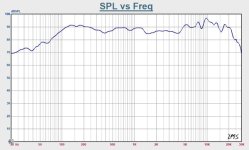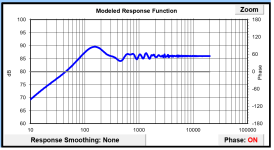I want to know about the subjective sound quality differences between these three drivers, if they all three are placed in an optimal cabinet .
Are there any differences and if they are, in what way ? What are the differences with these three units placed in optimal boxes, regarding SPL ?
I have the chn110 for the moment and its a very good sounding driver
Are there any differences and if they are, in what way ? What are the differences with these three units placed in optimal boxes, regarding SPL ?
I have the chn110 for the moment and its a very good sounding driver
Last edited:
Probably not a lot.What are the differences with these three units placed in optimal boxes, regarding SPL ?
jeff
Shown here is the Maop 11 ....would be OK for a mid-range...below 125 Hz, it falls on its face, & above 4500 hertz it starts screaming, trying to hit 100 Db.
-----------------------------------------------------------------------------------------------------------------------------------------------------------------------------------------------------------Rick...
-----------------------------------------------------------------------------------------------------------------------------------------------------------------------------------------------------------Rick...
Attachments
I have none of those drivers, only the 10s and P90. Each membrane material type has its characteristic sound which shows up in musical instrument tonality (woody-wind vs brassy; metally string vs rubberbandy; new words?), and perhaps more subtle, micro-dynamic articulation/linearity (contrasty mezzopiano to mezzoforte). MAOP possibly the most neutral and resolving, at the cost of a little bit of tone color and articulation contrast.
In terms of SPL, the broad efficiency / sensitivity ratings & differences are shown in the data sheets; not a great deal as far as that goes -they're all lurking around the 88.5dB 1m/w value, the slightly lower figure for 11MS being down to its marginally higher coil impedance. Under the 2.83v protocol MA have shifted to (so comparisons across different coil impedances can be made) they're much of a muchness.
'Optimal cabinets' & alignments vary from driver to driver since they have different load requirements, so it's difficult to make a direct comparison in the LF; CHN-110 gets lowest if given the enclosure size it requires, but again, this depends on your particular objects since maximum extension isn't always the goal.
As far as other differences go, you can see some of it in the published FR plots; these are on-axis; 11MS has slightly broader polars / dispersion / flatter power response due to the negative camber cone (it rolls back on itself at the periphery) although the others have very shallow profiles so aren't badly off in this sense; these are all effectively mechanical coaxes to some degree with the direct-bonded cap acting as a tweeter dome so the cone & surround profiles [basket & cap too of course] become significant in how much lateral output you can get: the less blockage / the flatter the main cone or the more negative camber it has while maintaining a relatively flat profile, the better the consistency in this sense.
MAOP 11 [like all the MAOP units] has more self-damping than the others; the faces of the substrate are converted to their ceramic [oxide] form; this progressively tapers off as you get deeper into the material, rather like the carburisation of armour facings does [e.g. Harvey, Krupp Cement etc.] so you have an interesting combination of features with the base aluminum/magnesium material at the core progressively converted to its ceramic oxide at the surface; the ceramic is stiffer, but the facing is rougher on a micro-level, and you have that shift in properties through the cone. This wouldn't really be very important for drivers intended for pistonic operation, but wideband drivers produce much of their output through TL [resonant] operation, so its properties -rigidity, damping characteristics etc. when formed to a given profile, coil & suspension start to take on a lot more significance. Speaking generally, having slightly more self-damping with greater rigidity [unusual] tends to make for better controlled / more linear cone behaviour. But you really need to do like-for-like comparisons since these drivers are quite different; it's not just the cone that's changed. IIRC there aren't any shared components between them.
'Optimal cabinets' & alignments vary from driver to driver since they have different load requirements, so it's difficult to make a direct comparison in the LF; CHN-110 gets lowest if given the enclosure size it requires, but again, this depends on your particular objects since maximum extension isn't always the goal.
As far as other differences go, you can see some of it in the published FR plots; these are on-axis; 11MS has slightly broader polars / dispersion / flatter power response due to the negative camber cone (it rolls back on itself at the periphery) although the others have very shallow profiles so aren't badly off in this sense; these are all effectively mechanical coaxes to some degree with the direct-bonded cap acting as a tweeter dome so the cone & surround profiles [basket & cap too of course] become significant in how much lateral output you can get: the less blockage / the flatter the main cone or the more negative camber it has while maintaining a relatively flat profile, the better the consistency in this sense.
MAOP 11 [like all the MAOP units] has more self-damping than the others; the faces of the substrate are converted to their ceramic [oxide] form; this progressively tapers off as you get deeper into the material, rather like the carburisation of armour facings does [e.g. Harvey, Krupp Cement etc.] so you have an interesting combination of features with the base aluminum/magnesium material at the core progressively converted to its ceramic oxide at the surface; the ceramic is stiffer, but the facing is rougher on a micro-level, and you have that shift in properties through the cone. This wouldn't really be very important for drivers intended for pistonic operation, but wideband drivers produce much of their output through TL [resonant] operation, so its properties -rigidity, damping characteristics etc. when formed to a given profile, coil & suspension start to take on a lot more significance. Speaking generally, having slightly more self-damping with greater rigidity [unusual] tends to make for better controlled / more linear cone behaviour. But you really need to do like-for-like comparisons since these drivers are quite different; it's not just the cone that's changed. IIRC there aren't any shared components between them.
Of course it does: you're showing an anechoic FR taken on an IEC 268-5 test baffle (simulated baffle response attached with relevant offset for the driver location).Shown here is the Maop 11 ....would be OK for a mid-range...below 125 Hz, it falls on its face,
I'm not sure any driver 'tries' to do something since they don't have a mind of their own 😉 (mind, I'm not sure I have either, today). Like many / most larger wideband drivers though it has a rising axial output peaking at 96dB (9.7KHz), mainly to help the power-response, since there's only so much you can do with the cone profile to improve the off-axis.Shown here is the Maop 11 ....would be OK for a mid-range...below 125 Hz, it falls on its face, & above 4500 hertz it starts screaming, trying to hit 100 Db.
Attachments
Not sure if this has been seen or mentioned around here yet, but I was just looking at the MAOP drivers (procrastinating at work) on MAs website to see what the lineup is at the moment and I noticed there is also a MAOP 11ms now https://www.markaudio.com/online_shop/11-cm/maop-11ms/
Can't see it for sale anywhere in Europe so I assume this is new
EDIT:
Just seen it's been mentioned on this thread, my bad - https://www.diyaudio.com/community/threads/markaudio-maop-11-single-driver-loudspeaker.413064/
Can't see it for sale anywhere in Europe so I assume this is new
EDIT:
Just seen it's been mentioned on this thread, my bad - https://www.diyaudio.com/community/threads/markaudio-maop-11-single-driver-loudspeaker.413064/
Last edited:

